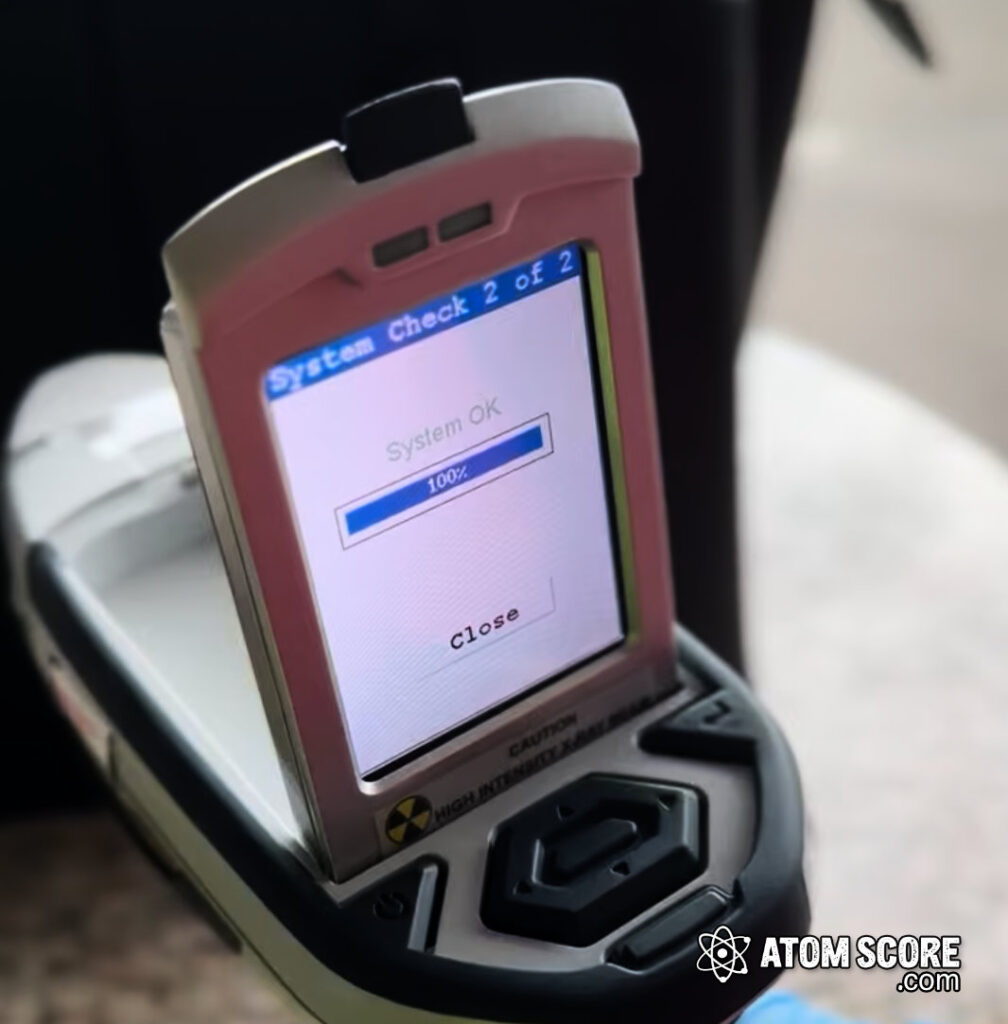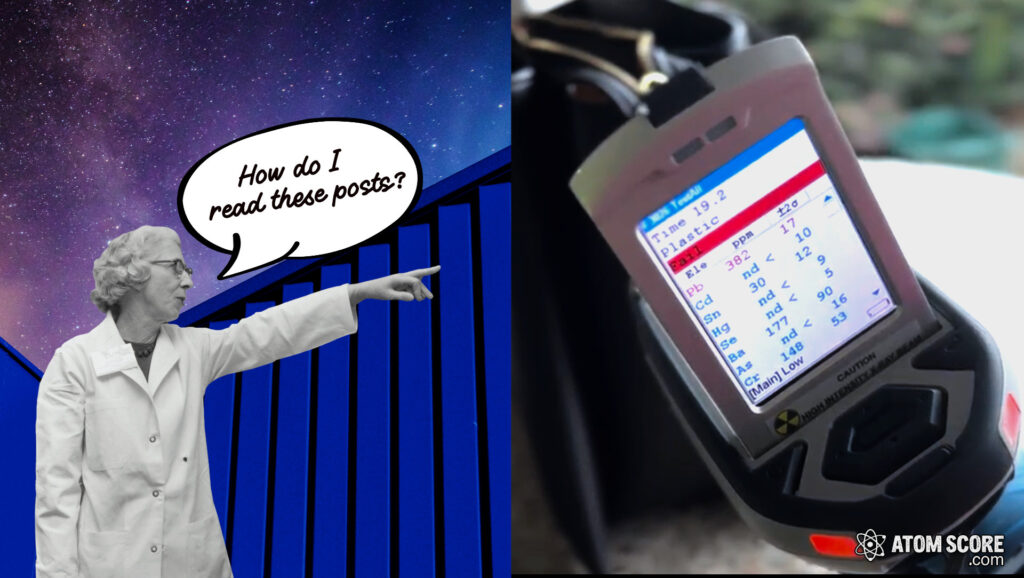To make our XRF results easy to read, we created this short guide to explain a few of the terms used in our posts.
How do you choose which tests to share on the website?
Each test we share on the website must meet our internal quality control standards. We run a system check on our instrument prior to the testing session and take several readings of each sample to verify the data we share is consistent, replicable, and reliable. We usually include a separate test summary for every major component that is accessible on the product, but we sometimes choose to focus on parts at high risk for lead (e.g., a fashion necklace on a garment).

Performing the System Check on the Niton XL3t
What does non-detect mean?
We refer to elements that are not detected by the instrument as non-detect. Please note an element may be present below the capacity of the XRF to detect it. Our XRF can typically detect lead to very trace levels in parts per million. The limit of detection for each element varies by sample and test duration.
Examples of lead that should not be screened using XRF are contaminants in food and cosmetics. Those products would need to be be tested by a lab and measured at a much lower parts per billion level.
Parts per million vs. parts per billion
ppm = parts per million (1 ppm = 1,000 ppb)
ppb = parts per billion (1,000 ppb = 1 ppm).
What is the +/- error value on the table?
The +\- error value is the variation of the measured value over the total duration of the test.
The majority of the error value occurs in the first few moments of testing. Longer testing times lower the +\- value. We test consumer goods up to 60 seconds.
What is the * symbol next to an element?
Elements where the error range is 50% or more of the detected value are considered detected but not quantified. We mark those elements with an asterisk (*) for your awareness.
What are the details below each table?
We identify the XRF instrument model, the software mode initially selected, and the length of time for the reading (generally 30 seconds for metals and 60 seconds for other materials.) We may include separate details about the sample and test conditions below each reading.
What are elements of interest?
Elements of interest are specific elements that we track and list at the top of each reading for your convenience. They are lead (Pb), cadmium (Cd), arsenic (As), mercury (Hg), and antimony (Sb).
We mostly focus on lead due to concerns identified by regulatory agencies, scientists, and state, federal, or international regulations pertaining to total lead in children’s products.
Cadmium is used for bright red and yellow pigments and is frequently detected in jewelry, dishes, and fine art. Arsenic and mercury were used in antiques as colorants but may occasionally appear at trace levels in modern consumer products. Antimony is used to produce flame retardant plastics and as a catalyst for some polyester fabrics.
We do not highlight all elements that are subject to migration testing in certain toy products likely to be mouthed by young children (barium, chromium, etc.) but we do provide the values for all these elements in our tables when they are detected.
Are the results considered quantitative?
In most cases, yes. Handheld XRF analyzers are excellent instruments for testing consumer products for lead and other restricted elements. You can find out about how the underlying technology works here. However, it is important to recognize that the quality of readings can be impacted by the sample and test conditions. We consider XRF to be a valuable screening tool to help moms and families identify lead in their personal products. We do not consider it to be a substitute for lab testing when a manufacturer is legally obligated to meet specific regulations to sell their product (e.g., a toy maker).
Consumer goods can pose interesting challenges when tested with XRF. Not all of the samples that we test will be larger than the scope of the instrument and not all parts and coatings can be tested in isolation. Some components are inaccessible, such as battery compartments, and we do not test those parts. We do not disassemble products or grind surface coatings, given we often test collectibles and pieces with historical value. Some of the items we test with XRF are vintage and the condition of coatings may vary. Our instrument is portable and we test items in the field, outside of controlled conditions.
Due to the fact that we test stuff in the real world, and samples vary, we cannot guarantee that the XRF tests will perfectly match those obtained through a laboratory under controlled conditions or utilizing destructive analytical techniques.
We have added boiler plate language to every item post to disclose the limitations of our data and content: “We provide our XRF testing for general educational or informational purposes only to help consumers identify low lead and lead-free products. We hereby disclaim any and all warranties, expressed or implied, and assume no duty or responsibility with respect to how any person or entity chooses to use the information on this website.”
When there are testing conditions that may impact the quantitative value of the reading – for example, when we test a product through a plastic bag – or an item is too small to fill the scope – we note these details under the table for the reader’s consideration. Not all relevant conditions may be adequately described.
How do you decide which items to recommend for the blog?
We try to be thoughtful when selecting items. We primarily avoid recommending products made with lead and cadmium, to reduce demand for these toxic materials and to protect any children living in a home who may potentially interact with the products.
We consider other items in the same product class as what we test, to determine whether or not an item is better than its peers. We consider durability, craftsmanship, and products we have had good experiences with ourselves, when possible. We try to offer a variety of different prices on products recommended through our affiliate links. In our opinion too many non-toxic groups cater to people who are wealthy with a large disposable income. We want to share options accessible to most families.
We also consider the overall non-toxic value of a product, and we reflect on the use of natural, eco-friendly materials and third-party chemical or organic certifications. We try to recommend products made without added flame retardants, PFAs, or PVC when those products are transparent and available.
We sometimes promote stuff made in the USA because we like to support domestic manufacturing and we find these options to be high quality. Your priorities may vary and that is fine. We only recommend items we would consider using ourselves.
Thank you. I hope this post has been helpful to you.


